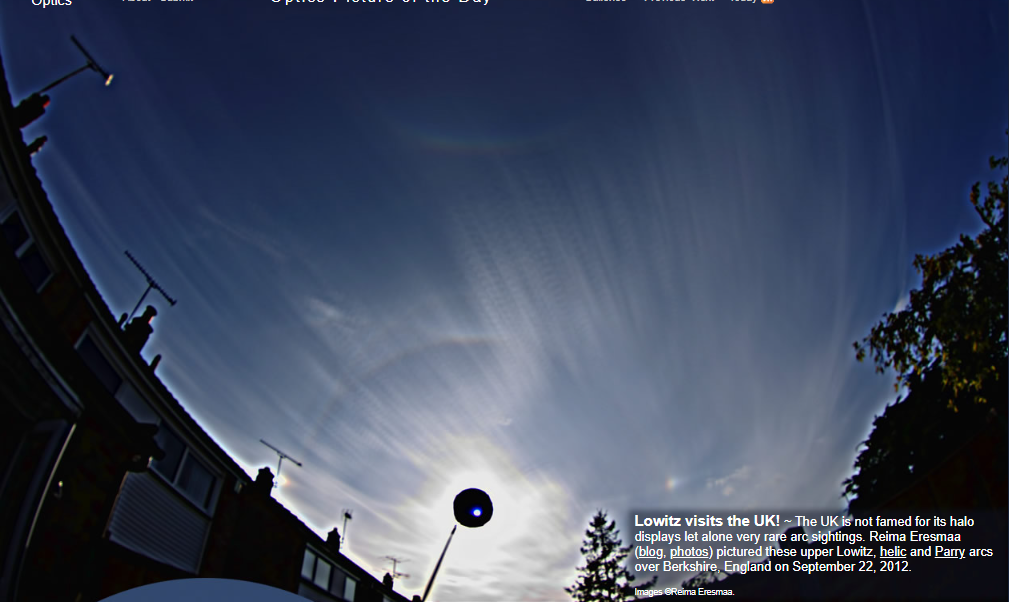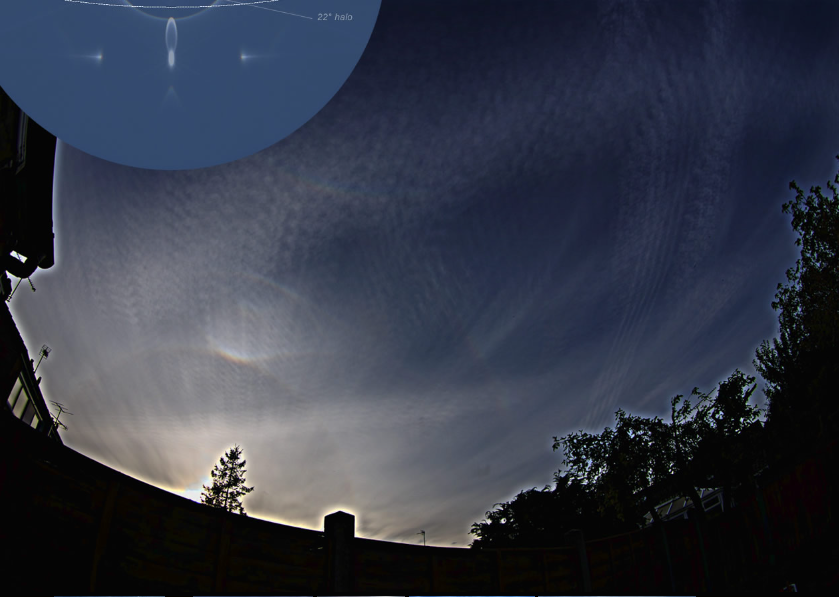OPOD - Lowitz Arcs in UK
OPOD - Lowitz Arcs in the UK: A Rare Atmospheric Optics Phenomenon
Atmospheric optics enthusiasts in the UK were treated to a rare spectacle on September 22, 2012, when Reima Eresmaa captured stunning images of Lowitz arcs over Berkshire, England. The UK is not particularly known for its halo displays, making this sighting all the more special. The photographs, each a stack of several images, reveal the intricate details of these elusive arcs that were once doubted to exist. Let's dive deeper into the world of Lowitz arcs and explore the mystery that surrounds them.
The Enigma of Lowitz Arcs
Lowitz arcs have long fascinated halo collectors not only for their perceived rarity but also due to the uncertainty surrounding their existence. Until relatively recently, doubts shrouded these optical phenomena. However, with advancements in technology and photography techniques, we now have a better understanding and appreciation of these captivating arcs.
Unveiling the Beauty of Lowitz Arcs
To fully appreciate the beauty of Lowitz arcs, it is important to understand their distinct characteristics. These arcs can be observed arching upwards towards the position of a Parry arc while crossing the upper tangent arc. However, spotting Lowitz arcs branching out from 22° parhelia towards the 22° halo can be more challenging.
Enhancing Visibility and Avoiding Misidentification
Photographers like Reima Eresmaa employ stacking techniques to enhance the visibility of Lowitz arcs and avoid misidentifying them as cloud streaks or other halo arcs. By combining multiple images, these photographers can capture the intricate details and subtle variations in the arcs, providing a clearer representation of their true nature.
Exploring the UK's Halo Displays
The United Kingdom may not be renowned for its halo displays, but this unique sighting of Lowitz arcs over Berkshire showcases the country's hidden atmospheric optics treasures. It serves as a reminder that even in regions less frequented by these phenomena, the sky can still surprise us with its extraordinary displays.
The Quest for Halo Collectors
Halo collectors around the world often seek out Lowitz arcs to add to their collections. These arcs hold a special allure, not only for their visual appeal but also because of their elusive nature. The rarity and mystery surrounding Lowitz arcs make them a highly sought-after phenomenon among atmospheric optics enthusiasts.
Capturing the Magic of Lowitz Arcs
Photographers and skywatchers who are fortunate enough to witness Lowitz arcs understand the significance of documenting these rare events. Through their lenses, they capture the ethereal beauty and intricate details of these optical phenomena, allowing others to marvel at their splendor.
Embracing the Mystery
While scientific advancements have shed light on the existence and nature of Lowitz arcs, there is still much to be discovered and understood about these atmospheric optics wonders. Embracing the mystery and continuing to document and study these rare events can provide valuable insights into the complexities of our atmosphere.
Conclusion
The appearance of Lowitz arcs over Berkshire, England in 2012 provided a unique opportunity for atmospheric optics enthusiasts in the UK. These captivating optical phenomena, once doubted to exist, continue to intrigue and inspire. As we delve deeper into the world of atmospheric optics, we uncover hidden treasures in the sky, reminding us of the vast wonders that surround us. The pursuit of understanding and appreciating these natural phenomena fuels our curiosity and drives us to explore further, uncovering the mysteries that lie within our atmosphere.

Lowitz visits the UK! ~ The UK is not famed for its halo displays let alone very rare arc sightings. Reima Eresmaa (blog, photos) pictured these upper Lowitz, helic and Parry arcs over Berkshire, England on September 22, 2012.
Images ©Reima Eresmaa.

The pictures are each stacks of several images (upper image 10 frames, lower 5). Stacking enhances arc visibility and avoids the misidentification of cloud streaks as halo arcs.
Lowitz arcs are perhaps the most sought by halo collectors, less so for their perceived rarity but because of the mystery that surrounded them. Until comparatively recently their very existence was doubted.
The upper Lowitz is best looked for arching upwards towards the position of a Parry arc and crossing the upper tangent arc. Lowitz arcs branching out from 22° parhelia towards the 22° are less easy to find.

Note: this article has been automatically converted from the old site and may not appear as intended. You can find the original article here.
Reference Atmospheric Optics
If you use any of the definitions, information, or data presented on Atmospheric Optics, please copy the link or reference below to properly credit us as the reference source. Thank you!
-
<a href="https://atoptics.co.uk/blog/opod-lowitz-arcs-in-uk/">OPOD - Lowitz Arcs in UK</a>
-
"OPOD - Lowitz Arcs in UK". Atmospheric Optics. Accessed on November 24, 2024. https://atoptics.co.uk/blog/opod-lowitz-arcs-in-uk/.
-
"OPOD - Lowitz Arcs in UK". Atmospheric Optics, https://atoptics.co.uk/blog/opod-lowitz-arcs-in-uk/. Accessed 24 November, 2024
-
OPOD - Lowitz Arcs in UK. Atmospheric Optics. Retrieved from https://atoptics.co.uk/blog/opod-lowitz-arcs-in-uk/.